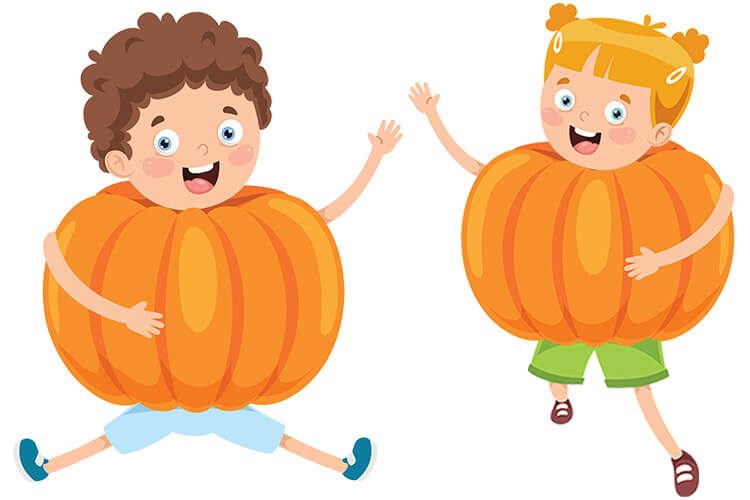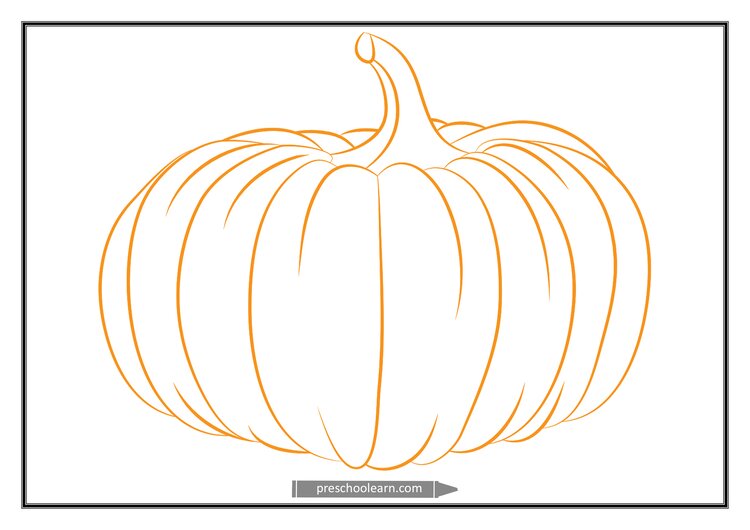While celebrating National Pumpkin Day preschoolers will get to know this vegetable in a polysensory way. They will practice manual skills by coring the pumpkins for seeds and creating a group artwork from them. Preschoolers will also help to cook pumpkin soup.
Educational aids:
a ‘Hello!’ song, boxes with holes for children’s hands, pumpkins in various sizes and colors, a calendar, a ‘Have you ever seen a pumpkin?’ nursery rhyme, the instrumental version of a ‘Did You Ever See a Lassie?’ song, a knife, the instrumental version of a ‘Where is Thumbkin?’ song, a ‘Mr. Pumpkin’ nursery rhyme, spoons, an hourglass, paper sheets, pumpkin seeds, pumpkin templates, glue sticks, a ‘Do You Know How Pumpkins Grow’ song, brushes, paints, potatoes, a carrot, an onion, garlic, olive oil, parsley, chicken soup/a bouillon cube, sour cream, aprons, knives, cutting boards, a blender, bowls, spoons.
Description of activities:
1. ‘Hello!’ – greeting children – children sit in a circle with the teacher. The teacher plays a song and shows the right movements. The group tries to imitate him/her.
Hello
Hello, hello, hello, how are you? (wave to each other)
Hello, hello, hello, how are you? (wave to each other)
I’m good. (show one thumb)
I’m great! (show two thumbs)
I’m wonderful! (raise thumbs up)
I’m good. (show one thumb)
I’m great! (show two thumbs)
I’m wonderful! (raise thumbs up)
Hello, hello, hello, how are you? (wave to each other)
Hello, hello, hello, how are you? (wave to each other)
I’m tired. (wipe your forehead with a hand)
I’m hungry. (massage your belly)
I’m not so good. (wave with your index finger)
I’m tired. (wipe your forehead with a hand)
I’m hungry. (massage your belly)
I’m not so good. (wave with your index finger)
2. ‘National Pumpkin Day’ – introducing the topic of the day – the teacher puts some boxes with holes for hands and with pumpkins inside on the carpet. Then he/she invites children one by one to put their hands in the holes, touch the items inside and try to guess what they are. The teacher asks children not to say about their guesses until he/she asks about it and all children touch it. Next, the teacher takes all pumpkins out of the boxes, points to the calendar and informs children that on the 26th of October we celebrate National Pumpkin Day.
3. ‘Have you ever seen a pumpkin?’ – a movement activity – the teacher plays the instrumental version of a ‘Did You Ever See a Lassie?’ song and sings the ‘Have you ever seen a pumpkin?’ lyrics. Children walk around in a circle and imitate the movements shown by the teacher.
Have you ever seen a pumpkin?
Tune: Did You Ever See a Lassie?
Adapted by DLTK’s Crafts for Kids
Have you ever seen a pumpkin, a pumpkin, a pumpkin, (look around)
Have you ever seen a pumpkin that grows on a vine? (show a vine with our hands)
A round one, a tall one, a fat one, a small one. (show a round, tall, fat and small pumpkins with our hands)
Have you ever seen a pumpkin that grows on a vine? (look around)
4. ‘What is a pumpkin?’ – a research activity – the teacher gives children various pumpkins and asks them to look at them carefully and check if they make any sounds, what they are like in touch and if they have any smell. One by one, children describe the colors and textures of pumpkins and try to divide them into edible and inedible ones. The teacher cuts the edible pumpkin in half and gives it to children so that they can smell it. Then he/she slices small pieces of pumpkin off and gives them to children to try. Next, children talk about their experiences connected with getting to know the pumpkins.
5. ‘Mr. Pumpkin’ – a movement activity – the teacher plays the instrumental version of a ‘Where is Thumbkin?’ song and sings the ‘Mr. Pumpkin’ lyrics. Children walk around in a circle, pass a small pumpkin from hand to hand and try to sing the song with the teacher.
Mr. Pumpkin
Tune: Where is Thumbkin?
Adapted by DLTK’s Crafts for Kids
Mr. Pumpkin,
Mr. Pumpkin,
Round and fat.
Round and fat.
Harvest time is coming.
Harvest time is coming.
Yum, yum, yum.
That is that!
A child who holds the pumpkin in his/her hands at the end of the nursery rhyme has to go inside the circle and do a chosen exercise, e.g. squats/standing on one leg. All children have to imitate this exercise. The activity is repeated 5-6 times. If preschoolers want to continue playing the teacher says that they can do it later, e.g. after lunch/snack.
6. ‘Who will core more seeds?’ – a manual activity – the teacher divides children into groups, e.g. by counting, and invites them to sit by the tables on which there are pumpkins and spoons. Children have to core as many seeds as possible during the time indicated by a hourglass. They can use spoons or their hands. After this time, preschoolers put seeds on the paper sheets. The teacher asks children what they can do with pumpkin seeds. Then he/she informs them/sums up that the seeds are very healthy. They have a lot of minerals and vitamins. We can eat them raw, dried or baked. Volunteers can taste the seeds and next children put the sheets with seeds in an indicated place, e.g. on a windowsill.
7. ‘Stick seeds to the pumpkins’ – a movement activity – the teacher places paper sheets with pumpkin templates, pumpkin seeds and glue sticks on the tables. Children (in groups from the previous activity) sit in rows. When the teacher plays a ‘Do You Know How Pumpkins Grow’ song, the first child from each row has to run to the table, take one seed, and stick it to the pumpkin template. Next, she or he comes back to her/his row and gives a high-five to the next person and this person starts to do the same. The activity lasts until all the pumpkins are ready. At the end children paint the pumpkins with paints.
8. ‘Pumpkin soup’ – a culinary activity – the teacher invites children to make a portion of pumpkin soup. They have to wash their hands and cut vegetables (a pumpkin, potatoes, a carrot and parsley). The teacher cuts garlic and onion. Next, the children put the vegetables in a pot with olive oil. The teacher informs them that vegetables have to be a little fried and then cooked with chicken soup/bouillon. Next, the teacher can blend the soup to show children how to make cream soup. Children can eat the soup e.g. for brunch (e.g. with sour cream and pumpkin seeds).
9. ‘Play with pumpkins’ – a movement activity – children stand in a circle with the teacher and make movements according to what the teacher says and shows.
Small pumpkins and big ones. (sit on the carpet and curl up into a ball, next stand on your toes and raise your hands up)
Pumpkins at the bottom and pumpkins at the top. (squat and jump up high)
Pumpkins on the right, pumpkins on the left. (jump right, then left)
Pumpkins want to play! (turn around)
Attachments:
Templates for the ‘Stick seeds to the pumpkins’ activity
Poster “National Pumpkin Day”
Pages:
- https://supersimple.com/song/hello/ – a ‘Hello!’ song
- https://www.youtube.com/watch?v=h7voee7jnYY&ab – the instrumental version of a ‘Where is Thumbkin?’ song for the ‘Mr. Pumpkin’ activity
- https://www.youtube.com/watch?v=SNz16CjKWvc&ab – the instrumental version of a ‘Did You Ever See a Lassie?’ song for the ‘Have you ever seen a pumpkin?’ activity
- https://www.youtube.com/watch?v=W7dUtUjzeag&ab – a ‘Do You Know How Pumpkins Grow’ song for the ‘Stick seeds to the pumpkins’ activity
- https://www.recipetineats.com/classic-pumpkin-soup/ – a pumpkin soup recipe for the ‘Pumpkin soup’ activity


